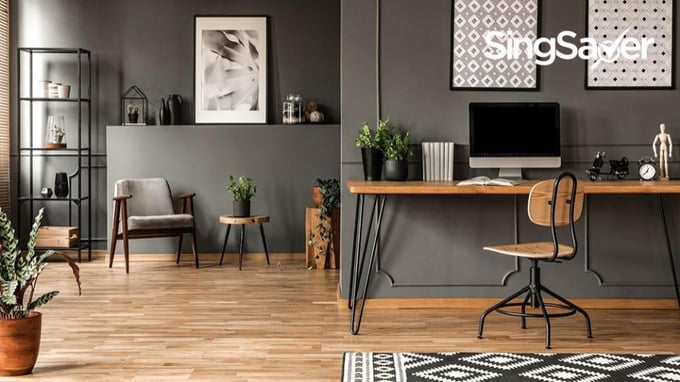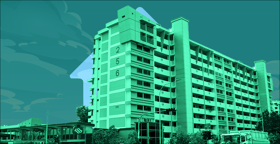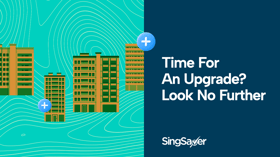Saving $300,000 for a flat in Singapore seems like a monumental feat. But if you start now, you'll be able to afford it by your 35th birthday.
To put things in context, the median price of a 3-Room Resale Flat in Ang Mo Kio is S$280,000, and the median price of a 4-Room BTO Flat in Fernvale Vines is S$313,500.
We know what you’re thinking: how can you possibly scrape together $300,000 for a flat by the time you're 35? It’s impossible. But countless Singaporeans have done it, and some even by their early 30s.
So don’t freak out; we’ll explain how exactly you can save enough money by your 35th birthday.
1. Ensure your CPF contributions are in order
Your CPF contributions, especially your employer’s 17% top-up, are critical to buying your first home. If you're taking out a HDB Concessionary Loan, Loan To Value (LTV) Ratio is 90% – this means that you can only borrow up to 90% of the flat’s valuation price. The remaining 10% must either be in cash or from your CPF OA.
As of 10 May 2019, the 90% LTV limit for HDB housing loans will be pro-rated based on whether the remaining lease of the unit covers the youngest buyer/owner to at least the age of 95.
If you're borrowing from a bank instead, the LTV is even lower at 75% – and an absolute minimum of 5% must be paid in cash (the remaining 20% can be paid in cash or from your CPF OA).
So if you are buying a flat that costs $300,000, and assuming that you're opting for a HDB Concessionary Loan, you must have at least $30,000 in cash for the down payment. If you haven’t accumulated this amount in your CPF, it can be painful to part with it from your bank account.
In addition, costs like the conveyancing fees (legal paperwork) can also come from your CPF. Monthly loan repayments can also come from your CPF. The alternative is to pay for all of these out of your own pocket. You can check your CPF online with your SingPass account.
2. Save at least 20% of your income, even after CPF
There are two reasons for doing this. First, it is a contingency in case your CPF is insufficient for the down payment, or if HDB does not extend you the full 90% loan (this sometimes happens, here are some possible reasons). In these cases, your savings will make up for the difference in cash.
Second, your savings exist to prevent debt. Should you encounter some kind of financial emergency, such as needing to find a new job or needing surgery, your savings will tide you over.
If you don’t have savings, you’ll probably have to resort to loans. This affects your Total Debt Servicing Ratio (TDSR) and afflicts you with interest repayments.
3. Get an endowment plan or blue chip investment plan
An endowment plan is an insurance plan with a savings component. Besides giving you insurance coverage, an endowment plan pays out a lump sum after a given period (e.g. 15 years).
Many people refer to endowment plans as "forced savings". An endowment plan can be used to fund something specific, such as a University education, a car, or the downpayment on a home. Most endowment plans grow your money at around 3 - 5% interest, which is much higher than a bank’s fixed deposit.
Alternatively, you might consider a blue chip investment plan (BCIP), which can be bought at banks such as OCBC and POSB. The cost can be as low as $100 per month.
Rather than pick specific blue chip companies, you may want to keep it simple by just buying a Straits Times Index Fund. The returns from ST Index funds are pegged to the ST Index, and due to low management fees may earn higher returns than endowment plans.
Speak to a financial advisor or wealth manager before investing.
It is inadvisable to hoard the money in a regular bank account and wait for 10 or 15 years. Regular accounts typically have an interest rate of around 0.125%, so you will effectively “lose” money after factoring in inflation.
4. Don’t buy a car before you buy a flat
When you purchase a flat, the lender (be it HDB or a private bank) will take into account your Total Debt Servicing Ratio (TDSR). TDSR measures your debt obligations against your income.
If you earn $5,000 a month, for example, and you have debts totalling $2,500, you would have a TDSR of 50%.
With rare exceptions, you will not be granted a loan if the repayments would raise your TDSR above 60%. You will either have to apply for a smaller loan (which can mean not getting the house you want), or clear out your debts before trying again.
For this reason, do not buy a car just before buying a flat. The five-year car loan is expensive, and will contribute so much to your TDSR that you'll have a tough time getting a home loan.
5. Avoid credit card debt
Credit cards in Singapore can be great tools for saving money and squeezing the most value out of every dollar spent – as long as you use them right. That means making full repayment every time. If you maintain rollover debt (you don’t pay credit card bills in full), two things can happen.
The first is that all your savings and investments, be they endowment plans or fixed deposits, will be wiped out to pay the high interest on your credit card. It is almost impossible to “out-save” the credit card interest rate of 24% per annum.
Second, if you are late with credit card repayments – or have a history of only making minimum repayments – this will affect your credit rating. Both banks and HDB may choose to grant your smaller loans, or refuse to give you loans altogether. Your history with credit cards does impact your chances of buying a flat.
Read more: What Should You Do If You Can’t Pay Your Credit Card Bill?
6. Choose a loan with the lowest interest rate
You may not have a choice about debt. Sometimes you will need an education loan, or a loan for family reasons, or any of the other times in life when it makes sense to consider getting a personal loan.
If this happens, you must be extremely stingy. Nitpick over details, such as administrative fees, and compare loan options extensively to get the lowest rate.
Read our round-up of the 3 Best Personal Loans in Singapore with the Lowest Interest Rates, and when you're ready, compare and apply for the best personal loan through SingSaver to get exclusive rates and sign-up bonuses!
Read these next:
How To Buy A House in Singapore: A Complete Guide
HDB BTO Launches In 2020 (Sembawang, Toa Payoh, Choa Chu Kang, Tengah, Pasir Ris, Tampines)
What Type of HDB Flats Can Single Singaporeans Buy?
How to Qualify and Apply for the HDB Loan?
5 Renovation Tips To Maximise The Value of Your First Home

By Ryan Ong
Ryan has been writing about finance for the last 10 years. He also has his fingers in a lot of other pies, having written for publications such as Men's Health, Her World, Esquire, and Yahoo! Finance.
Similar articles
What Happens If: I Can’t Afford My Mortgage Repayments?
5 Questions You’ll Regret Not Asking Before Buying Your First Flat
5 Money-Saving Methods That Don’t Work
Avoid Buying a Flat in Singapore Right After Your Wedding
How to Save Money for a Singapore Wedding in 6 Months
What You Need To Know About The New Housing Loan Rules
How Much Can You Borrow For Your Home Loan?
7 Things You Need To Consider Before Buying A Home. Really.










